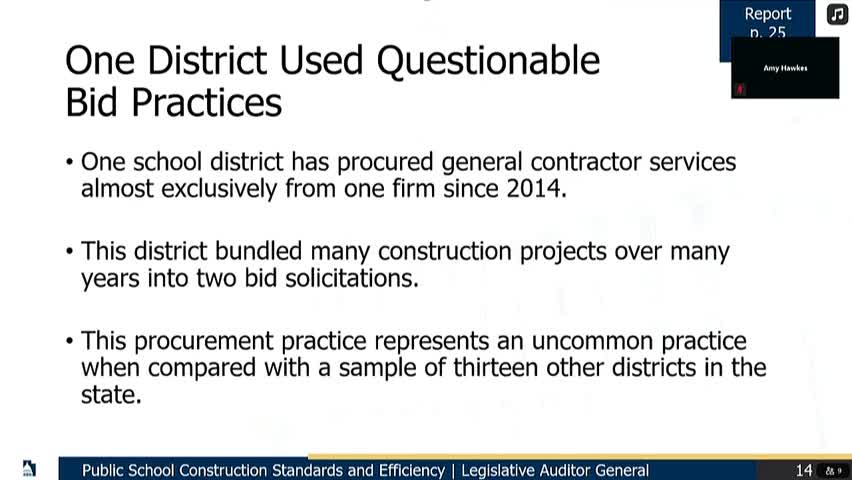Audit Reveals Cost Discrepancies and Safety Issues in School Construction Projects
September 16, 2025 | 2025 Utah Legislature, Utah Legislature, Utah Legislative Branch, Utah
This article was created by AI summarizing key points discussed. AI makes mistakes, so for full details and context, please refer to the video of the full meeting. Please report any errors so we can fix them. Report an error »

The Education Interim Committee of the Utah Legislature convened on September 16, 2025, to discuss critical issues surrounding school construction costs and safety compliance. The meeting began with a presentation highlighting the findings of an audit focused on the financial practices of Local Education Agencies (LEAs) regarding school building expenditures.
The first significant topic addressed was the concern raised by Representative Lisenby regarding the high costs associated with new school constructions, particularly in larger districts. Lisenby pointed out that many architectural features, while visually appealing, do not contribute to the educational environment and may not be worth the taxpayer dollars spent. She suggested the possibility of implementing standardized building plans for junior high and high schools to ensure cost-effectiveness and accountability.
In response, the audit team acknowledged the challenges in comparing construction costs across districts due to inconsistent reporting practices. They emphasized the need for a standardized cost reporting system to facilitate better comparisons and potentially identify areas for savings. The audit also noted that while some states have adopted standardized blueprints for school construction, Utah has not yet implemented such measures.
The discussion then shifted to the oversight of safety compliance in school buildings. Concerns were raised about the adequacy of inspections and whether current safety regulations were being met. The audit revealed instances of non-compliance with safety standards, particularly in mechanical and plumbing systems. The committee members debated whether the responsibility for ensuring compliance should revert to local municipalities, which traditionally handled such oversight, rather than the state board.
Senator Reebay highlighted the financial strain on school districts due to unfunded mandates, which detract from instructional budgets. She emphasized the need for a balance between safety regulations and the financial realities faced by smaller communities. The committee acknowledged the tension between the desire for aesthetically pleasing school buildings and the necessity for functional, safe learning environments.
The meeting concluded with a commitment to further explore the recommendations from the audit, including the potential for legislative action to improve oversight and standardization in school construction practices. The committee expressed a shared goal of ensuring that taxpayer funds are utilized effectively to enhance educational outcomes for students across Utah.
The first significant topic addressed was the concern raised by Representative Lisenby regarding the high costs associated with new school constructions, particularly in larger districts. Lisenby pointed out that many architectural features, while visually appealing, do not contribute to the educational environment and may not be worth the taxpayer dollars spent. She suggested the possibility of implementing standardized building plans for junior high and high schools to ensure cost-effectiveness and accountability.
In response, the audit team acknowledged the challenges in comparing construction costs across districts due to inconsistent reporting practices. They emphasized the need for a standardized cost reporting system to facilitate better comparisons and potentially identify areas for savings. The audit also noted that while some states have adopted standardized blueprints for school construction, Utah has not yet implemented such measures.
The discussion then shifted to the oversight of safety compliance in school buildings. Concerns were raised about the adequacy of inspections and whether current safety regulations were being met. The audit revealed instances of non-compliance with safety standards, particularly in mechanical and plumbing systems. The committee members debated whether the responsibility for ensuring compliance should revert to local municipalities, which traditionally handled such oversight, rather than the state board.
Senator Reebay highlighted the financial strain on school districts due to unfunded mandates, which detract from instructional budgets. She emphasized the need for a balance between safety regulations and the financial realities faced by smaller communities. The committee acknowledged the tension between the desire for aesthetically pleasing school buildings and the necessity for functional, safe learning environments.
The meeting concluded with a commitment to further explore the recommendations from the audit, including the potential for legislative action to improve oversight and standardization in school construction practices. The committee expressed a shared goal of ensuring that taxpayer funds are utilized effectively to enhance educational outcomes for students across Utah.
View full meeting
This article is based on a recent meeting—watch the full video and explore the complete transcript for deeper insights into the discussion.
View full meeting

